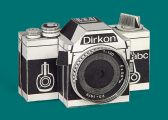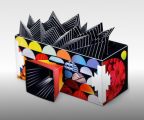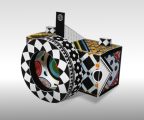When I'm ready to take a picture, I loosen the lens cap. When the camera is steady, I pull the lens cap away for one second, and then place it back tightly over the lens barrel. Pictures taken in the shade or on a cloudy day require longer exposure times.
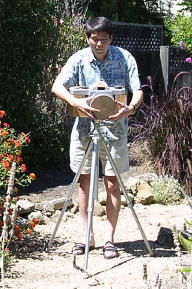
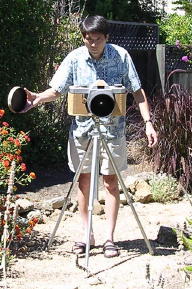
The lens barrel serves as a lens shade by blocking direct sunlight from falling on the pinhole. The pinhole is just a sheet of ordinary aluminum foil that has been pricked lightly with a sharp sewing needle. I taped the aluminum foil to a doughnut-shaped piece of poster board, which fits snugly inside another ring of poster board glued to the flat cardboard inside the lens barrel. This construction allowed me to experiment with "interchangeable pinholes," although I never actually tried using any other pinholes.
The pinhole (not visible in the photo above) is located in the center of the shiny foil area. I wrote the notation "~f/360, f/16 + 9 stops" which means that the "focal length" (pinhole-to-film distance) divided by the pinhole diameter is about 360, which is about nine f-stops smaller than f/16. Using Kodak Tri-X film with an ASA of 400, an exposure of a scene lit with bright sunlight would be about 1/400 of a second at f/16 in my regular Pentax camera, or about 1 second at f/360 using the pinhole camera. I didn't actually measure the diameter of the pinhole, but guessed its size based on the length of time that gave a good exposure.
After exposing the film, I took the camera into the darkroom, opened the back, slipped out the sheet film, and hand-developed it in trays of developer, stop bath, and fixer. When the film was dry, I made contact prints on photographic paper.
I haven't used the camera to take pictures since the early 1980s. Although I still have a supply of Kodak Tri-X 4x5 film for the camera, I sold all of my darkroom equipment several years ago, after I got my first digital camera.
